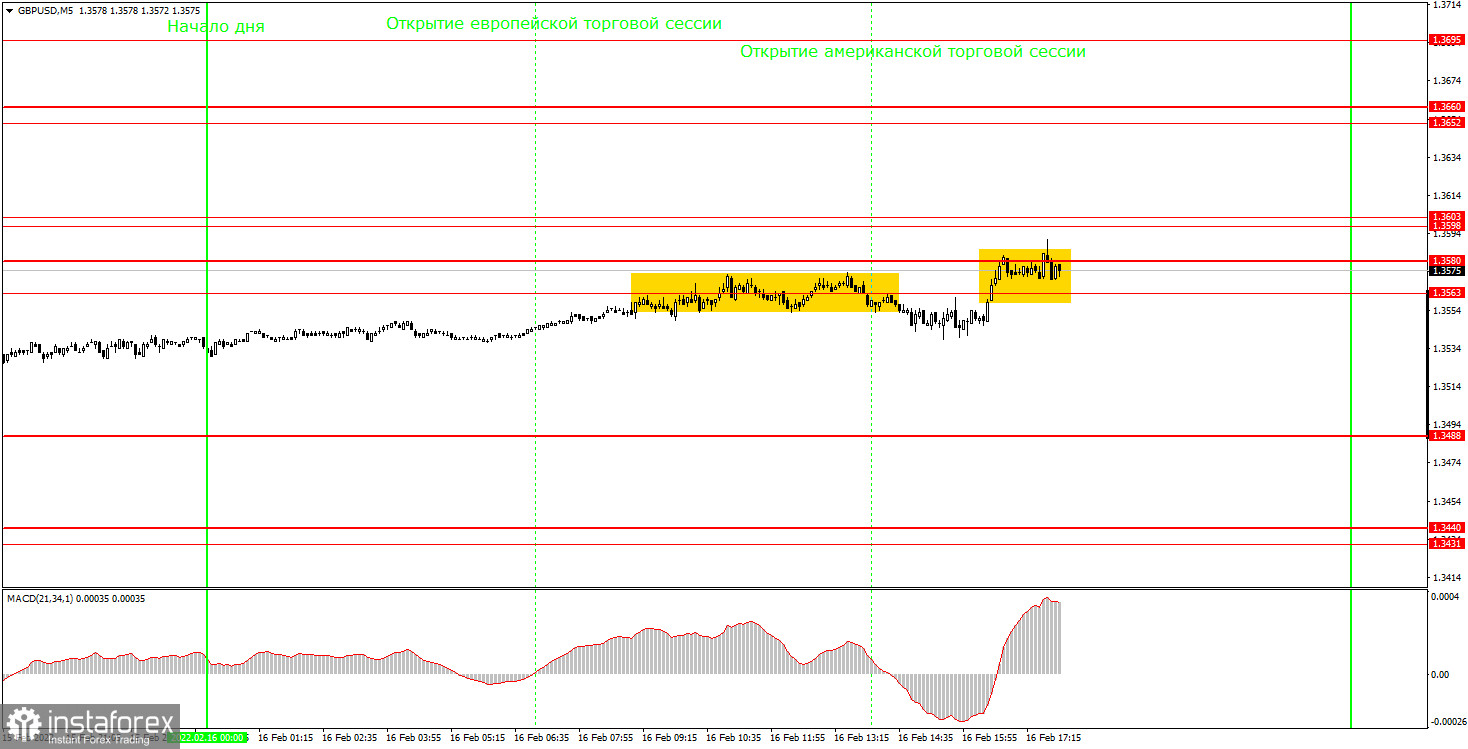Analyzing trades on Wednesday:
GBP/USD on 30M chart

The GBP/USD pair continued its upward movement on Wednesday after rebounding from the level of 1.3488 a day earlier. By the end of the day, it ended up near the level of 1.3580 and failed to break through it at the first attempt. On a larger scale, we had a pure flat movement that could not even be called a sideways channel. But in the last few days, the channel has taken on clear lines and boundaries. Now the pair is holding between the levels of 1.3488 and 1.3580 and cannot leave this range. We have already mentioned that the pound has been trading mixed in recent weeks. The technical picture looks complicated for all time frames. So, it is hard to predict anything even one day ahead. On Wednesday, in addition to the US retail sales data, an important inflation report for January was published in the UK. Although the reading exceeded the forecast, it did not provoke any strong movement on the pair. The daily volatility was within 57 pips, which is slightly more than on the euro/dollar pair.
GBP/USD on 5M chart

On the 5-minute time frame, the technical conditions were awful. There is no doubt that the pound was trading flat. The price slowly approached the area of 1.3563-1.3580 and was struggling to either break through or rebound from it for the next 5-6 hours. At the beginning of the North American session, the price eventually started to decline. This move could be interpreted as a sell signal, and beginners could open short positions with it. However, it took too long for the signal to form, which is a clear sign of its weakness. Therefore, it was not necessary to open a trade. Then the price once again tried to overcome the area of 1.3563-1.3580 but failed to do it until the evening. Therefore, this signal should have been ignored anyway. Moreover, even if the price had managed to overcome this zone, it would have immediately faced another resistance area of 1.3598-1.3603. So, despite some important macroeconomic events, market activity on the pound/dollar pair was very low on Wednesday.
Trading tips on Thursday:
On the 30-minute time frame, the uptrend was canceled, but the pair could not form a downtrend either. The pair has been trading between the levels of 1.3488 and 1.3643 for eight days in a row. In the last few days, it has firmly settled between 1.3488 and 1.3580. Thus, there is no trend now, and the pair may continue to show weak movements with low volatility. On the 5-minute chart on Thursday, it is recommended to trade at the levels of 1.3431-1.3440, 1.3488, 1.3563-1.3580, 1.3598-1.3603, and 1.3652-1.3660. As soon as the price moves by 20 pips in the right direction, you should set a Stop Loss to a breakeven point. On Thursday, there will be now important events or publications in the UK. In the US, only a few minor reports will be released, which will most likely be ignored by the market. So, novice traders will have to rely mostly on technical signals. You should be careful,though, as the pair may enter a flat channel.
Basic rules of the trading system
1) The strength of the signal is determined by the time it took the signal to form (a rebound or a breakout of the level). The quicker it is formed, the stronger the signal is.
2) If two or more positions were opened near a certain level based on a false signal (which did not trigger a Take Profit or test the nearest target level), then all subsequent signals at this level should be ignored.
3) When trading flat, a pair can form multiple false signals or not form them at all. In any case, it is better to stop trading at the first sign of a flat movement.
4) Trades should be opened in the period between the start of the European session and the middle of the US trading hours when all positions must be closed manually.
5) You can trade using signals from the MACD indicator on the 30-minute time frame only amid strong volatility and a clear trend that should be confirmed by a trendline or a trend channel.
6) If two levels are located too close to each other (from 5 to 15 pips), they should be considered support and resistance levels.
On the chart
Support and Resistance Levels are the levels that serve as targets when buying or selling the pair. You can place Take Profit near these levels.
Red lines are channels or trend lines that display the current trend and show in which direction it is better to trade now.
The MACD indicator (14, 22, and 3) consists of a histogram and a signal line. When they cross, this is a signal to enter the market. It is recommended to use this indicator in combination with trend patterns (channels and trendlines).
Important announcements and economic reports that can be found on the economic calendar can seriously influence the trajectory of a currency pair. Therefore, at the time of their release, we recommend trading as carefully as possible or exiting the market in order to avoid sharp price fluctuations.
Beginners on Forex should remember that not every single trade has to be profitable. The development of a clear strategy and money management is the key to success in trading over a long period of time.
 English
English 
 Русский
Русский Bahasa Indonesia
Bahasa Indonesia Bahasa Malay
Bahasa Malay ไทย
ไทย Español
Español Deutsch
Deutsch Български
Български Français
Français Tiếng Việt
Tiếng Việt 中文
中文 বাংলা
বাংলা हिन्दी
हिन्दी Čeština
Čeština Українська
Українська Română
Română

